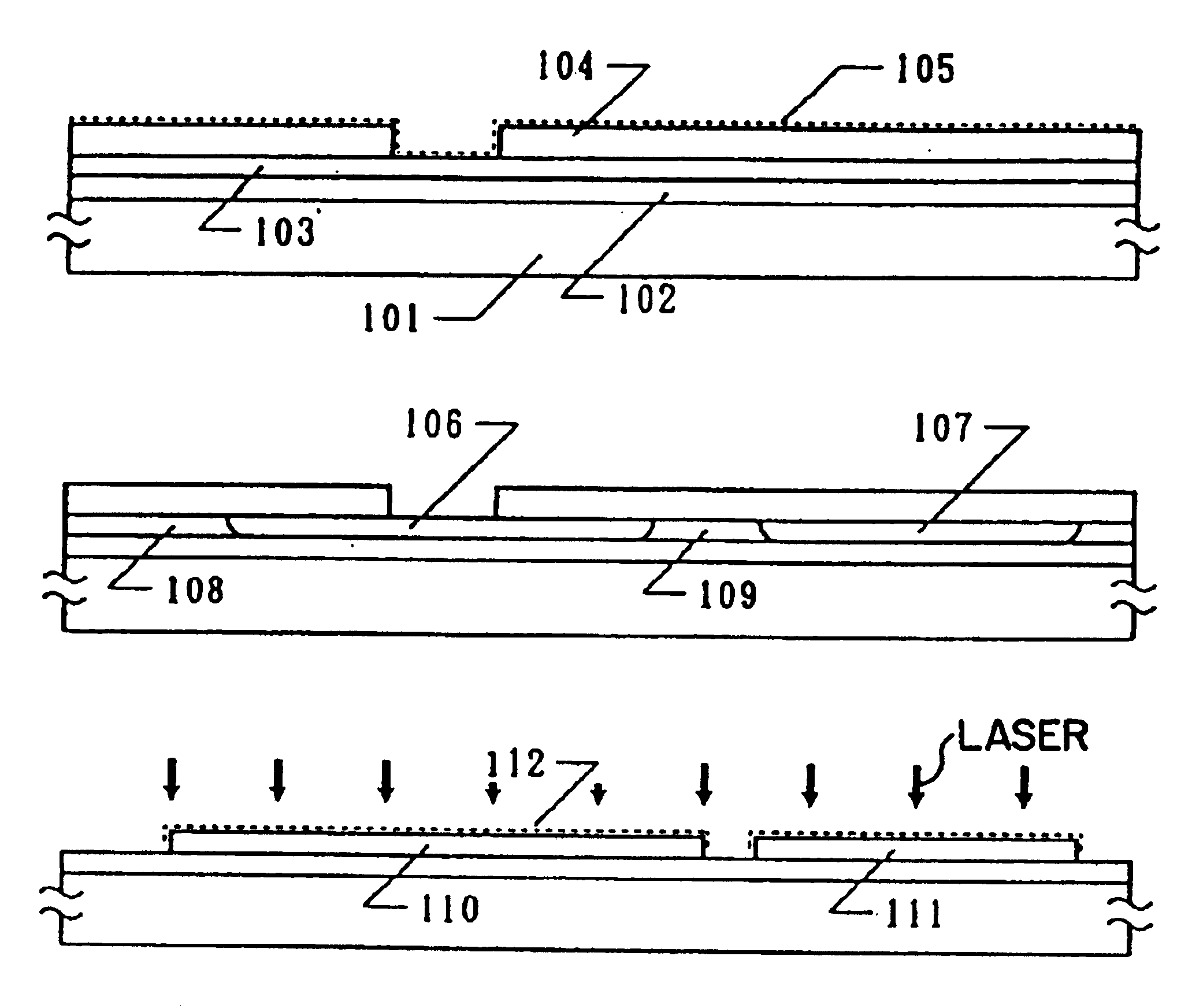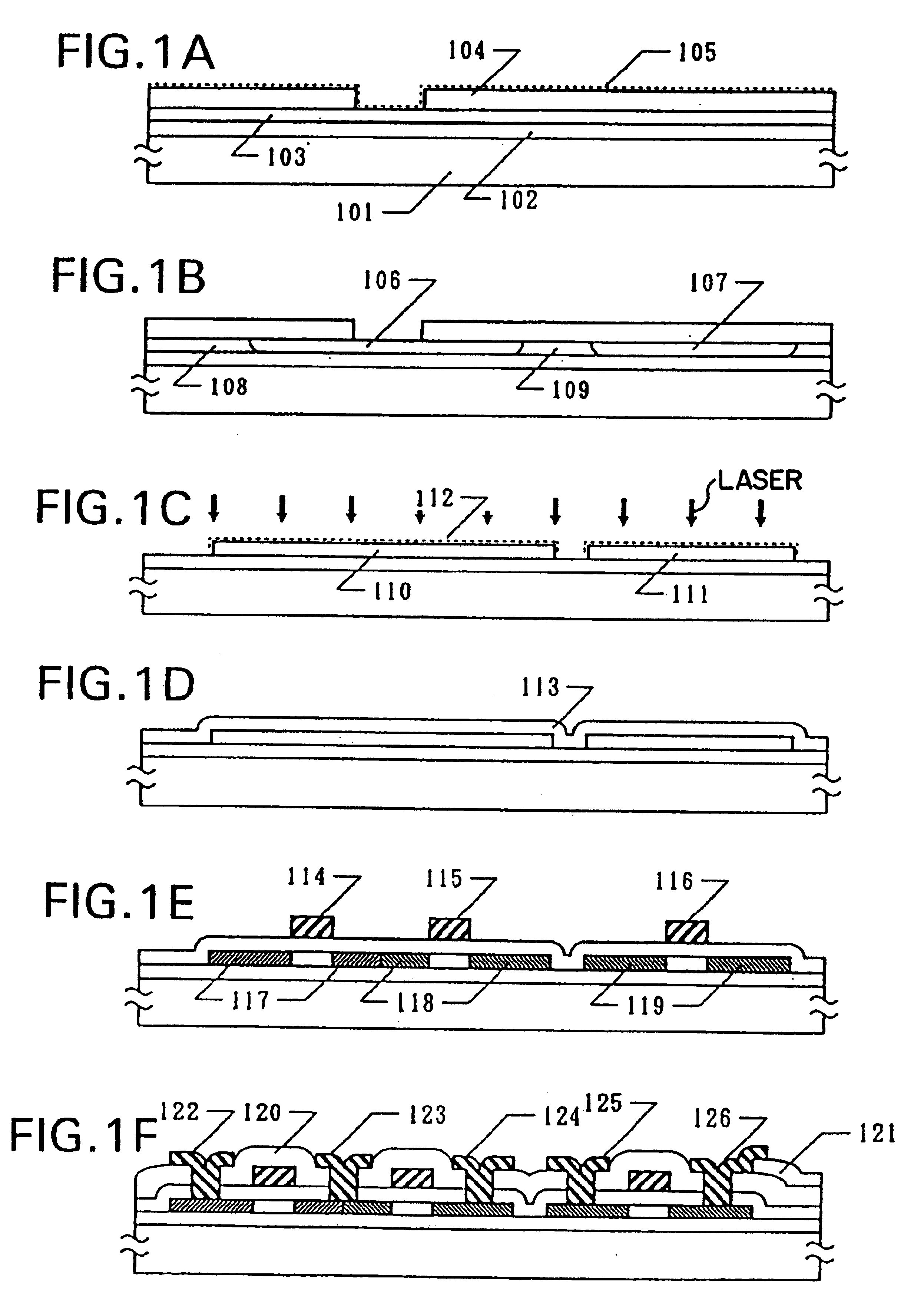Method for manufacturing semiconductor device with crystallization of amorphous silicon
a technology of amorphous silicon and a semiconductor device, which is applied in the direction of semiconductor devices, basic electric elements, electrical appliances, etc., can solve the problems of not being suitable for a semiconductor device, not being able to match well with a silicon film, and tending to trap the charge of the film, so as to achieve high reliability and ensure the characteristics of the film to a certain degr
- Summary
- Abstract
- Description
- Claims
- Application Information
AI Technical Summary
Benefits of technology
Problems solved by technology
Method used
Image
Examples
example 1
[0048]The present example refers to a process for fabricating a crystalline silicon film on the surface of a glass substrate. Referring to FIGS. 1A-1F, a Corning 7059 glass substrate 100 mm×100 mm in size and 1.1 mm in thickness was prepared. A silicon nitride film from 1,000 to 5,000 Å, for example, 2000 Å thickness was deposited as a base film 102 by sputtering or plasma CVD on the substrate 101. The stoichiometric ratio of nitrogen and silicon (nitrogen / silicon) was set to 1.3 to 1.35, preferably 1.32 to 1.34.
[0049]The silicon nitride film is formed, for example, by a plasma CVD with the following conditions:[0050]RF power: 13.56 MHz, 300 W[0051]Substrate Temperature: 300° C.[0052]SiH4 / NH3=30 sccm / 210 sccm[0053]Pressure: 0.3 Torr
[0054]Generally, when the temperature is higher, the concentration of hydrogen in the obtained film is reduced.
[0055]Then, an amorphous silicon film 103 was deposited to a thickness of 100 to 1,500 Å, for example, 800 Å by plasma CVD or LPCVD.
[0056]A sili...
example 2
[0073]The process for fabricating a semiconductor device according to the present example will be described below with reference to FIGS. 3A to 3F. A silicon oxide film 202 was deposited by a known method such as plasma CVD to a thickness of 1,000 to 5,000 Å, for example, 2000 Å as a base film on a Corning 7059 glass substrate 201 (10 cm×10 cm in size). An amorphous silicon film 203 was deposited by plasma CVD or reduced pressure CVD to a thickness of 1,000 Å.
[0074]After forming an ultra-thin silicon oxide film (not shown) on the surface of the amorphous silicon film using aqueous hydrogen peroxide, 5 ml of an acetate solution containing 25 ppm of nickel was dropped onto the oxidized surface of the amorphous silicon film in the same manner as in Example 1. Further, at this time, spin-coating was effected at 50 rpm for a duration of 10 seconds to form a uniform aqueous film over the entire surface of the substrate. After further retaining this state for a duration of 5 minutes, spin-...
example 3
[0085]A process for fabricating a semiconductor device according to a third example will be described below with reference to FIGS. 4A to 4F. A silicon oxide film 302 was deposited through plasma CVD to a thickness of 2,000 Å as a base film on an NH 35 glass substrate 301 (NH Technoglass Co., Ltd.). After depositing the base film, the structure was annealed in a temperature range of from 620 to 660° C. for a duration of from 1 to 4 hours, and was gradually cooled at a rate of 0.1 to 1.0° C. / minute, preferably from 0.1 to 0.3° C. / minute. The substrate was taken out when the temperature was cooled to 450-590° C.
[0086]An amorphous silicon film 303 was deposited by plasma CVD to a thickness of 300 to 1,200 Å, e.g. 500 Å. Then, a nickel acetate layer of 20 to 50 Å thick was formed by spin coating in the same manner as the foregoing Examples 1 and 2, using a mask 304 made of a silicon nitride film of 1,000 to 3,000 Å thick, e.g. 2,000 Å. As described in Example 1, it was necessary to form...
PUM
| Property | Measurement | Unit |
|---|---|---|
| temperature | aaaaa | aaaaa |
| temperature | aaaaa | aaaaa |
| size | aaaaa | aaaaa |
Abstract
Description
Claims
Application Information
 Login to View More
Login to View More - R&D
- Intellectual Property
- Life Sciences
- Materials
- Tech Scout
- Unparalleled Data Quality
- Higher Quality Content
- 60% Fewer Hallucinations
Browse by: Latest US Patents, China's latest patents, Technical Efficacy Thesaurus, Application Domain, Technology Topic, Popular Technical Reports.
© 2025 PatSnap. All rights reserved.Legal|Privacy policy|Modern Slavery Act Transparency Statement|Sitemap|About US| Contact US: help@patsnap.com



